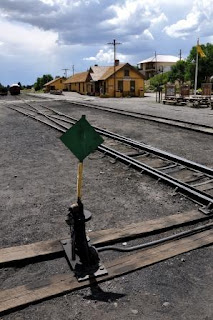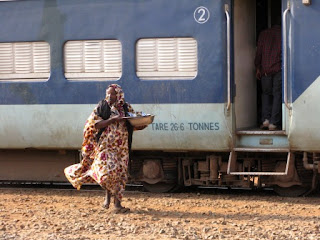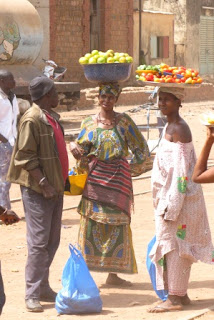"My goal was to create a building that reflects the new stations potential significance as a high speed inter-urban link between Europe’s cities.
I imagined a building without facades with a soaring roof above offering protection from the elements (particularly the ever present rain of the Belgian Winter). This could maintain the views through and of the station. The vaulted shape was a natural development of this vision while the soft (perhaps feminine) undulating curve of the roof was selected to mimic the graceful rise and fall of the Cointe hills beyond.
I felt that there was no better way to celebrate the technological achievement of the TGV trains than to expose the working platforms and the dynamism of the moving ensemble of passengers and trains."
Santiago Calatrava
Excerpted from Architect’s Statement
The station was completed in 2009. It's a photographer's dream
http://www.arcspace.com/architects/calatrava/liege/
the station is particularly fascinating as a background for 50 year old trains...
Thursday, October 20, 2011
Friday, September 9, 2011
Remainders of the great days of railroading (9)... the Nevada Northern Railway
The Nevada Northern Railway was a railroad in Nevada, built primarily to provide rail access to a major copper producing area in Ruth, close to Ely. The railway, constructed in 1905-06, extended northward approximately 140 miles from Ely to a connection with the Southern Pacific Railroad at Cobre. The copper ore was transported from Ruth to a smelter at McGill, not far east of Ely.
As a subsidiary of the Nevada Consolidated mining company, the primary purpose of the Nevada Northern throughout its history was the haulage of copper ores and products. Other freight traffic was also carried, however, and the railroad operated a daily passenger train between East Ely and Cobre until 1941. Local trains were also operated from Ely to Ruth and McGill for the benefit of mine employees and others until the 1930s.
Faced with declining ore reserves and low copper prices, Kennecott closed its Ruth-area mines in May 1978, thus ending the ore trains between Ruth and the McGill smelter. The smelter itself closed on June 20, 1983, and the Nevada Northern suspended all operations immediately thereafter.
In a series of donations beginning in 1986, Kennecott Copper Corporation transferred the entire Ore Line, as well as the railroad's yard and shop facilities in East Ely, to the White Pine Historical Railroad Foundation, a non-profit organization which today operates the property as the Nevada Northern Railway Museum.
In summer, there are daily trains between East Ely and the former mine, and between East Ely and the former smelter.
The main line to Cobre still exists, but is not used any more. There were revivals of mining at McGill, and several plans of building power stations north of Ely, which would bring new traffic to the line.
http://en.wikipedia.org/wiki/Nevada_Northern_Railway
In East Ely, the depot and the machine shops, engine shed, coaling towers and other buildings are preserved in the original state.
It is a real travel back in time to walk around here. In the engine shed, even the toilets, showers and lockers are preserved.
As a subsidiary of the Nevada Consolidated mining company, the primary purpose of the Nevada Northern throughout its history was the haulage of copper ores and products. Other freight traffic was also carried, however, and the railroad operated a daily passenger train between East Ely and Cobre until 1941. Local trains were also operated from Ely to Ruth and McGill for the benefit of mine employees and others until the 1930s.
Faced with declining ore reserves and low copper prices, Kennecott closed its Ruth-area mines in May 1978, thus ending the ore trains between Ruth and the McGill smelter. The smelter itself closed on June 20, 1983, and the Nevada Northern suspended all operations immediately thereafter.
In a series of donations beginning in 1986, Kennecott Copper Corporation transferred the entire Ore Line, as well as the railroad's yard and shop facilities in East Ely, to the White Pine Historical Railroad Foundation, a non-profit organization which today operates the property as the Nevada Northern Railway Museum.
In summer, there are daily trains between East Ely and the former mine, and between East Ely and the former smelter.
The main line to Cobre still exists, but is not used any more. There were revivals of mining at McGill, and several plans of building power stations north of Ely, which would bring new traffic to the line.
http://en.wikipedia.org/wiki/Nevada_Northern_Railway
In East Ely, the depot and the machine shops, engine shed, coaling towers and other buildings are preserved in the original state.
It is a real travel back in time to walk around here. In the engine shed, even the toilets, showers and lockers are preserved.
Engine 40 in the shop in East Ely
Monday, September 5, 2011
Denver and Rio Grande Western.... remainders of the great days of railroading (8)
After 1870, the Denver and Rio Grande Railroad built an extensive network of 3 foot narrow gauge lines in Southern Colorado and northern New Mexico. In 1929, the railroad operated 805 miles of track and had 91 steam engines. They even operated a long distance passenger train from Alamosa to Durango, the "San Juan". The coaches had reclining seats and there was a parlor/dining car. The first part of the line to Antonito was three tracks, so it could be used by narrow gauge and standard trains. The Rio Grande Southern additionally operated 174 miles with 13 engines in 1929.
In 1967, the Rio Grande stopped operation except of the branch from Durango to Silverton, which was "embarrasingly" successful. The weekly train started to be used by tourists and they even had to built new cars in 1964. In 1979 this operation was bought by Charles Bradshaw, who continues to operate it.
http://www.durangotrain.com/
Whereas the Silverton line is quite commercial and touristy, the other part of the line from Chama to Antonito, preserved by the states of Colorado and New Mexico and operated by the Cumbres and Toltec Scenic Railway is a step back in time.
You are free to wander around, admire the historic depot and the wide selection of material standing around in Chama.
http://www.cumbrestoltec.com/
There is one daily pair of trains and with 64 miles, it is probably the longest daily operated steam train run remaining in the world.
The boiler of one of these rotary snow plows exploded on the similar Rio Grande Southern.
The original wood coaling tower is still used
In 1967, the Rio Grande stopped operation except of the branch from Durango to Silverton, which was "embarrasingly" successful. The weekly train started to be used by tourists and they even had to built new cars in 1964. In 1979 this operation was bought by Charles Bradshaw, who continues to operate it.
http://www.durangotrain.com/
Whereas the Silverton line is quite commercial and touristy, the other part of the line from Chama to Antonito, preserved by the states of Colorado and New Mexico and operated by the Cumbres and Toltec Scenic Railway is a step back in time.
You are free to wander around, admire the historic depot and the wide selection of material standing around in Chama.
http://www.cumbrestoltec.com/
There is one daily pair of trains and with 64 miles, it is probably the longest daily operated steam train run remaining in the world.
The boiler of one of these rotary snow plows exploded on the similar Rio Grande Southern.
The original wood coaling tower is still used
Living in the desert (3) .... annals of architecture (2): the earthship
Earthships are sustainable homes made from recycled materials.
The pictures show an earthship village close to Taos, New Mexico
The walls are made of tyres, bottles and metal cans.
Water is collected and used several times, finally to irrigate plants in the inside and outside gardens. Only for times of extreme drought water has to be pumped up from a well. Electricity is generated by solar collectors and windmills. An intricate system of ventilation and heat collection makes air conditioning or heating redundant.
The buildings have quite a Gaudiesque appearance
http://www.earthship.com/
The pictures show an earthship village close to Taos, New Mexico
The walls are made of tyres, bottles and metal cans.
Water is collected and used several times, finally to irrigate plants in the inside and outside gardens. Only for times of extreme drought water has to be pumped up from a well. Electricity is generated by solar collectors and windmills. An intricate system of ventilation and heat collection makes air conditioning or heating redundant.
The buildings have quite a Gaudiesque appearance
http://www.earthship.com/
Friday, May 13, 2011
The sahel express.... remainders of the great days of railroading (7)
Construction work using forced labour on the Dakar–Niger Railway began at the end of the 19th century under the French general Gallieni commander of French Sudan
The railroad connected the Niger River with the port of Dakar. The line was completed at the beginning of the 20th century, the Kayes-Koulikoro section being inaugurated in 1904, but the final section of line did not open until 1924.
The line covers a course of 1,287 km of which 641 km lies in Mali.The track gauge is 1000 mm
Engines in the station in Dakar. End february, the suburban commuter trains were not running due to bad tracks.
The railway uses old Indian 1000 mm engines and coaches, which are not needed there any more since the Indians change to broad gauge
Open air repair shop in the Dakar station
The railway is in a much worse shape in Senegal than in Mali. Freight trains run all the way to Koulikouro beyond Bamako, but there are passenger trains only in Mali between Bamako and Kayes close to the Senegal border.
The border station at Kayes
The fantastic colonial hotel du rail in Kayes....
....and its reception....
.... and restaurant
Mali is dependant on the railroad. It has no ports and the railroad is the only means of transportation to the next sea port at Dakar
The freight trains entering Mali are fully loaded. The trains leaving Mali are empty.... they don't produce a lot. Here a freight train at Bamako station. The railroad is owned by trainsrail, a canadian company
Three times a week this train connects Bamako and Kayes at the border. It could also run somewhere in Radjastan
The Bamako - Kayes train leaves at 7.15 in Bamako and arrives in Kayes at 22.00.
It stops at all intermediate stations. For some people, this is the only chance to make a couple of RFA six times a week.
The bargains are made at the train window. The train is safe. Non-passengers are not allowed to board, there are security guards and all the seats are reserved
In between the many stops, the train rides about 80, which is quite good for the circumstances.
A "griot", a traveling singer on the train
Village on the way from Bamako to Kayes
Station restaurant and....
....local luggage transport
Accidents seem to happen. In Senegal, 5 were killed on May, 13th 2009
A station mosque
Bamako station
Inside the station hall
One of the passenger cars.... not used any more. This former French car used to go from Bamako to Dakar
The nice former conductor, who opened the doors for me at Bamako station
Mostly people are honest in Mali. A lost passport awaiting its owner at Bamako station
http://en.wikipedia.org/wiki/Dakar%E2%80%93Niger_Railway
The railroad connected the Niger River with the port of Dakar. The line was completed at the beginning of the 20th century, the Kayes-Koulikoro section being inaugurated in 1904, but the final section of line did not open until 1924.
The line covers a course of 1,287 km of which 641 km lies in Mali.The track gauge is 1000 mm
Engines in the station in Dakar. End february, the suburban commuter trains were not running due to bad tracks.
The railway uses old Indian 1000 mm engines and coaches, which are not needed there any more since the Indians change to broad gauge
Open air repair shop in the Dakar station
The railway is in a much worse shape in Senegal than in Mali. Freight trains run all the way to Koulikouro beyond Bamako, but there are passenger trains only in Mali between Bamako and Kayes close to the Senegal border.
The border station at Kayes
The fantastic colonial hotel du rail in Kayes....
....and its reception....
.... and restaurant
Mali is dependant on the railroad. It has no ports and the railroad is the only means of transportation to the next sea port at Dakar
The freight trains entering Mali are fully loaded. The trains leaving Mali are empty.... they don't produce a lot. Here a freight train at Bamako station. The railroad is owned by trainsrail, a canadian company
Three times a week this train connects Bamako and Kayes at the border. It could also run somewhere in Radjastan
The Bamako - Kayes train leaves at 7.15 in Bamako and arrives in Kayes at 22.00.
It stops at all intermediate stations. For some people, this is the only chance to make a couple of RFA six times a week.
The bargains are made at the train window. The train is safe. Non-passengers are not allowed to board, there are security guards and all the seats are reserved
In between the many stops, the train rides about 80, which is quite good for the circumstances.
A "griot", a traveling singer on the train
Village on the way from Bamako to Kayes
Station restaurant and....
....local luggage transport
Accidents seem to happen. In Senegal, 5 were killed on May, 13th 2009
A station mosque
Bamako station
Inside the station hall
One of the passenger cars.... not used any more. This former French car used to go from Bamako to Dakar
The nice former conductor, who opened the doors for me at Bamako station
Mostly people are honest in Mali. A lost passport awaiting its owner at Bamako station
http://en.wikipedia.org/wiki/Dakar%E2%80%93Niger_Railway
Subscribe to:
Posts (Atom)




























































